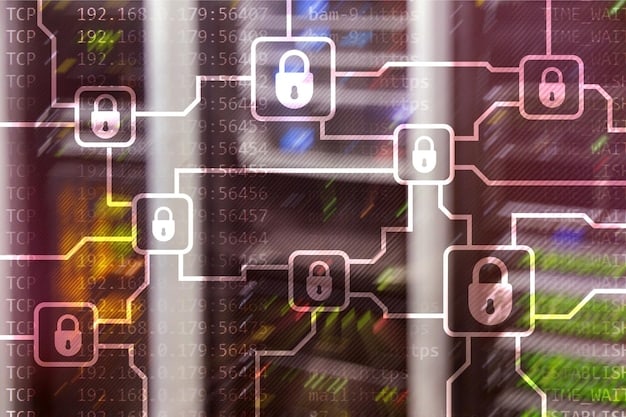Esports Cybersecurity: Securing Your Organization in the US

Esports cybersecurity is crucial for protecting organizations in the US from data breaches and financial losses by implementing robust security measures, educating personnel, and staying updated on the latest threats and regulations.
In the rapidly expanding esports industry, the stakes are high, and so are the risks. Esports cybersecurity: protecting your organization from data breaches and financial losses in the US is no longer optional—it’s a necessity. This guide delves into the critical aspects of esports cybersecurity, providing actionable strategies to safeguard your organization.
Understanding the Cybersecurity Landscape in Esports
The esports industry has unique cybersecurity challenges due to its heavy reliance on digital platforms, valuable player data, and significant financial transactions. Understanding these unique aspects is the first step in formulating a robust defense.
High-Value Targets in Esports
Esports organizations possess a treasure trove of data that makes them attractive targets for cybercriminals. This includes player profiles, financial records, and proprietary game strategies. All are extremely valuable and must be protected.
Common Cyber Threats to Esports Organizations
From phishing attacks to ransomware, esports organizations face a variety of cyber threats. Recognizing these threats is crucial for implementing effective security measures and protection.
- DDoS Attacks: Disrupting live events and online platforms.
- Phishing: Tricking individuals into revealing sensitive information.
- Ransomware: Encrypting data and demanding payment for its release.
- Account Takeovers: Gaining unauthorized access to player or organizational accounts.
Cyber threats are not just technical inconveniences; they can lead to significant financial losses, reputational damage, and operational disruptions within esports organizations.

Developing a Comprehensive Cybersecurity Strategy
A comprehensive cybersecurity strategy is the foundation for protecting your esports organization. This involves assessing risks, implementing security measures, and establishing clear policies.
Conducting a Risk Assessment
Identifying vulnerabilities and potential threats is the first step in creating an effective cybersecurity strategy. A risk assessment helps you prioritize security efforts and invest resources wisely. Evaluate all aspects of the organization: technology, people, and processes.
Implementing Security Measures
There are specific security measures that must be emplaced across all elements of the business. This includes firewalls, intrusion detection systems, multi factor authentication to name a few.
- Firewalls: Act as a barrier between your network and the internet.
- Intrusion Detection Systems: Monitor network traffic for suspicious activity.
- Multi-Factor Authentication (MFA): Adds an extra layer of security to prevent unauthorized access.
- Data Encryption: Protects sensitive information by converting it into an unreadable format.
Implementing strong security measures requires an ongoing, vigilant approach. Regular audits and updates are just some of the ways to combat potential threats.
Protecting Player Data and Accounts
Player data and accounts are prime targets for cybercriminals in the esports industry. Safeguarding this information is essential for maintaining trust and credibility.
Implementing Strong Password Policies
Enforcing strong password policies is a simple yet effective way to protect player accounts. Require complex passwords and encourage regular updates and changes.
Securing Player Devices and Networks
Protecting player devices and networks is crucial, especially when players are competing from remote locations. Ensure that they have secure internet connections and up-to-date security software. This is critical when thinking about how data can be stolen remotely.

Training and Education for Esports Personnel
Human error is a significant factor in many cybersecurity breaches. Training and educating esports personnel about cybersecurity best practices is essential for creating a culture of security.
Creating a Security Awareness Program
A security awareness program should cover topics such as phishing, social engineering, and password security. Regular training sessions and awareness campaigns can help employees recognize and avoid cyber threats. Include real-world examples and simulations to make training engaging and effective.
Simulated Phishing Exercises
Simulated phishing exercises can help identify employees who are vulnerable to phishing attacks. This allows you to provide targeted training to those who need it most. Use these exercises as learning opportunities, not punitive measures.
Compliance and Legal Considerations in the US
Esports organizations in the US must comply with various cybersecurity laws and regulations. Understanding these requirements is essential for avoiding legal issues.
Relevant Cybersecurity Laws and Regulations
Several laws and regulations may apply to esports organizations, depending on the type of data they collect and process. Examples include the California Consumer Privacy Act (CCPA) and the General Data Protection Regulation (GDPR).
Working with Legal Counsel
Consulting with legal counsel is essential for ensuring compliance with all applicable laws and regulations. Legal experts can help you develop policies and procedures that meet the requirements of these laws.
Incident Response and Recovery Planning
Despite the best security measures, cybersecurity incidents can still occur. Having an incident response and recovery plan in place is essential for minimizing the impact of such incidents.
Creating an Incident Response Plan
An incident response plan should outline the steps to take in the event of a cybersecurity incident. This includes identifying the incident, containing the damage, eradicating the threat, and recovering data and systems. Include clear roles and responsibilities for team members.
Regularly Testing and Updating the Plan
The incident response plan should be regularly tested and updated to ensure that it remains effective. Conduct simulations to identify gaps in the plan and improve response times.
An esports cybersecurity plan is an essential asset moving into the future for companies. Without one, breaches and large losses of assets can occur.
| Key Point | Brief Description |
|---|---|
| 🛡️ Risk Assessment | Identify vulnerabilities and potential threats to prioritize security measures. |
| 🔑 Password Policies | Enforce strong, complex passwords and regular updates for all accounts. |
| 👨🏫 Training Programs | Educate personnel on phishing, social engineering, and security best practices. |
| 🚨Incident Response | Create and regularly test a plan to minimize the impact of cybersecurity incidents. |
Frequently Asked Questions
▼
Cybersecurity is vital for protecting sensitive data, preventing financial losses, and maintaining the integrity of esports competitions. Breaches can damage reputation and disrupt operations.
▼
Common threats include DDoS attacks, phishing scams, ransomware, and account takeovers. These can lead to significant financial and reputational damage if not properly addressed proactively.
▼
Implementing strong password policies, securing player devices and networks, and using multi-factor authentication can help protect player data, as well as a robust, monitored cybersecurity plan.
▼
An incident response plan should outline steps for identifying, containing, eradicating, and recovering from cybersecurity incidents. It should also include roles and responsibilities.
▼
Training promotes awareness and helps personnel recognize and avoid cyber threats like phishing. Regular training sessions and simulations enhance the organization’s security culture significantly.
Conclusion
Protecting your esports organization from cybersecurity threats is an ongoing process that requires vigilance, investment, and a commitment to security best practices. By implementing the strategies outlined in this guide, you can help safeguard your organization from data breaches and financial losses, ensuring a secure and successful future in the competitive world of esports.





